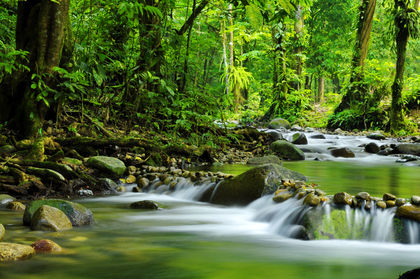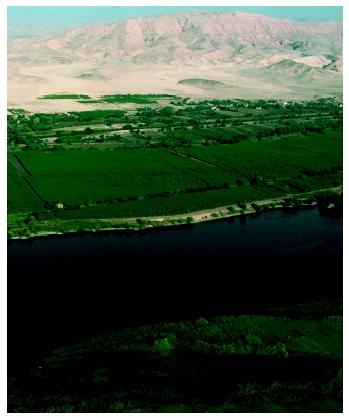Rivers and Streams

On the continents, aquatic ecosystems are of two kinds: lotic ecosystems, in which the water is free-flowing (streams and rivers), and lentic ecosystems, in which the water is relatively stationary. The scientists who specialize in aquatic ecosystems are limnologists.
Physical Features
The limiting factors that govern what organisms can live in lotic ecosystems include current, light intensity, temperature, pH , dissolved oxygen, salinity, and nutrient availability—variables routinely measured by limnologists to develop a profile of the environment. These conditions differ greatly between small headwater streams and the mouths of such great rivers such as the Mississippi and the Amazon. Living occupants of streams and rivers show corresponding differences along the way.
Small headwater streams, where water first collects by runoff from the land or emerges from springs, are called first-order streams. When two first-order streams meet, they form a second-order stream; two of these converge to form a third-order stream, and so on, until the water may flow into bodies as large as twelfth-order rivers (for example, the Columbia and the Mississippi). Bodies of the first to third order are usually considered streams, and those of the fourth order and larger are considered rivers.
Streams provide diverse habitats including relatively swift rapids and quiet pools. They often have hard substrates of stones, rubble, or bedrock to which animals can cling. Flat rocks and rubble typically harbor the greatest species diversity of stream animals. Stream animals often have flat, streamlined bodies that are not easily swept away by currents, and hooks, suckers, or sticky undersides for clinging to substrates. They tend to face into a current and swim against it, behavior called rheotaxis. Lake animals,

Food Chains and Ecosystem Structure
The bank of a stream or river is called the riparian zone, a place where overhanging foliage provides shade and the tree roots of undercut banks provide shelter. The deep shade produced by riparian foliage limits photosynthesis and primary production of organic nutrients. Much or most of the organic matter that nourishes the stream habitat originates as foliage that falls into the water, ranging from leaves, twigs, and seeds to fallen trees. Aquatic food chains in first-order streams thus begin with coarse particulate organic matter. This matter enters the food chain by way of aquatic bacteria and fungi that decompose it, and animals classified as shredders that tear it into finer particles. Shredders produce nutrient-rich feces that, in turn, are eaten by collectors. Farther downstream where there is more light, algae grow on rocks and other submerged surfaces and support a small community of animal grazers. Most shredders, collectors, and grazers are aquatic insects, but snails, bivalves, and crustaceans also play a part. The total population of these invertebrates is relatively small, however, so there are few predators in headwater streams; there is not enough for them to eat.
Rivers, being wider, have more surface exposed to sunlight, so their primary productivity (photosynthesis) is greater. This is aided by inorganic nutrients such as nitrogen and phosphorus flowing down from the smaller-order streams. Fourth- to sixth-order rivers provide ideal conditions for algae and rooted aquatic plants because of their softer substrates and ample light. Shredders become less abundant, grazers increase, and the relative populations of collectors and predators remain about the same. Species diversity increases in these mid-order rivers, with fish and burrowing animals such as clams and worms becoming more common. High-altitude, cold, oxygen-rich midsized rivers are an ideal haven for trout, which feed on the insect community. The organisms in midsized rivers, where there is more photosynthesis, produce more organic matter than they consume, and the excess nourishes the larger rivers downstream.
Large rivers (seventh to twelfth order) are relatively deep and wide. They are rich in organic matter but also contain a lot of inorganic sediment produced by erosion and runoff into the upland waters. Thus, the water is more turbid (muddy), and there is insufficient light to support as much photosynthesis as in smaller rivers. Collectors and predators dominate the consumer community, and consumption exceeds primary production. Fish species such as sturgeon and catfish, which feed on sediments, are more common here than predatory fish.
All lotic organisms must adapt to drift, the incessant flow of water toward the sea, carrying nutrients and the organisms themselves downstream. Drift is particularly significant when spring snowmelts and heavy summer rains increase the current. River valleys offer especially rich farmland because of the great quantities of nutrients deposited by periodic flooding. Nutrient loss by drift is compensated for by the continual addition of riparian organic matter to the lower-order upland streams, while animals compensate for drift by their rheotaxis and other means. Many aquatic insects fly upstream to lay their eggs, and fish such as trout and salmon are well known for their upstream spawning runs. The immature animals drift downstream as they grow and typically reach maturity at lower altitudes, only to repeat the process and deposit their offspring back in the headwaters.
SEE ALSO Ecosystem ; Lakes and Ponds ; Limnologist
Kenneth S. Saladin
Bibliography
Cole, Gerald A. Textbook of Limnology, 4th ed. Prospect Heights, IL: Waveland Press, 1994.
Giller, Paul S., and Bjorn Malmqvist. The Biology of Streams and Rivers. New York: Oxford University Press, 1999.
Wetzel, Robert G. Limnology: Lake and River Ecosystems, 3rd ed. Burlington, MA: Academic Press, 2001.
Comment about this article, ask questions, or add new information about this topic: